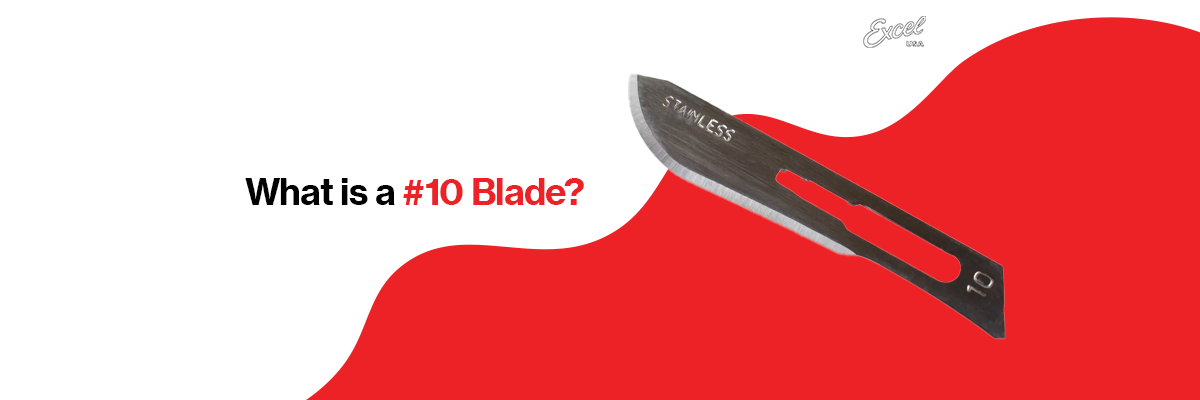
What is a 10 Blade? A Complete Guide to the Curved Workhorse for Cutting and Dissection
If you've ever worked in a lab, medical classroom, or detailed craft studio, chances are you've encountered a #10 blade. But what is a 10 blade, and why is it so widely used in both clinical and creative settings?
In this comprehensive guide, we’ll answer:
- What a #10 blade is and how it's designed
- How it differs from #11 and #15 blades
- What materials and applications it's best suited for
- Blade safety, handling, and disposal
- The most common users and their workflows
Whether you’re a medical student, model builder, or artist, understanding the #10 blade is essential for precision and safety.
What is a 10 Blade?
A #10 blade is a curved-edge scalpel blade commonly used for precise incisions in both medical and crafting applications. Its broad, curved cutting edge resembles a miniature utility knife, allowing smooth, sweeping cuts.
Main Characteristics of a 10 Blade:
- Rounded belly for curved incisions
- Slightly angled tip for controlled entry
- Fits standard scalpel handles
Its versatility makes it a staple for surgical procedures, artwork, and model-making projects.

10 Blade vs 11 Blade vs 15 Blade: What’s the Difference?
Choosing between these blades depends on the precision, depth, and style of the cut you need. Here's how they compare:
- Shape: Curved belly
- Use Case: Smooth, sweeping incisions
- Best For: Skin incisions, foam shaping, carving curves
- Shape: Triangular with a sharp point
- Use Case: Precision punctures, narrow cuts
- Best For: Delicate detail work, craft stenciling, vein entry
- Shape: Small curved edge with a fine tip
- Use Case: Controlled shallow cuts
- Best For: Plastic surgery, hobby model slicing, tight corners
Related: How to Choose a Scalpel Blade for Your Application
Common Applications of a 10 Blade
1. Medical and Surgical Use
In hospitals and teaching labs, the #10 blade is used for:
- Making initial incisions in skin and soft tissue
- Dissecting during general surgery
- Teaching scalpel technique to students
Its large cutting surface makes it ideal for clean entry wounds and broad dissection areas.
2. Crafting and Model Building
For artists and hobbyists, a 10 blade works wonders on:
- Foam core boards
- EVA foam
- Leather and vinyl
- Wax or clay sculpture
Its curved edge enables precise contour cutting and shaping—great for cosplay, miniature building, and sculpture.
3. Laboratory Work
In scientific labs, it’s used for:
- Sample preparation
- Tissue dissection
- Plant sectioning
Especially in biology, the 10 blade helps with repetitive, consistent cuts.
What Materials Can You Cut with a 10 Blade?
The #10 blade is best suited for soft to medium-density materials, such as:
|
Material |
Use Example |
|
Skin & tissue |
Surgical incisions |
|
EVA foam |
Cosplay builds |
|
Cardboard |
Model base shaping |
|
Rubber sheets |
Precision trimming |
|
Leather |
Curved cutting or hole tracing |
|
Paper & vinyl |
Cutting decals or design outlines |
How to Use a 10 Blade Safely
Using any scalpel blade—including the 10 blade—requires attention and discipline.
Safety Tips:
- Always use with a compatible handle (usually No. 3)
- Cut away from your body and fingers
- Use a cut-resistant mat and gloves for protection
- Store in a blade-safe container after use
- Dispose of blades in a sharps container
Note: Never leave a 10 blade uncovered on a workspace.
How to Attach and Remove a 10 Blade
To Attach:
- Use needle-nose pliers or a blade remover
- Slide the base of the blade into the groove of the handle
- Ensure it clicks securely into place
To Remove:
- Use a blade remover or push the blade backward with pliers
- Never use your fingers to detach
- Place used blade immediately in a sharps container
You May Also Watch: #11 Craft Knife Replacement Blade
Frequently Asked Questions
Is a 10 blade only for medical use?
Not at all. While commonly used in surgeries, it’s also a favorite among model builders, sculptors, and crafters for curved and precision cuts.
What handle does a 10 blade use?
A #10 blade typically fits a No. 3 scalpel handle, which is standard in surgical kits and crafting sets.
Can I use a 10 blade on foam?
Yes! It’s great for EVA foam, craft foam, and insulation sheets, especially when creating rounded or sloped cuts.
Choosing the Right 10 Blade for Your Needs
Look for these features when shopping for 10 blades:
- Stainless steel or carbon steel construction
- Individually wrapped for safety
- Compatible with standard scalpel handles
- Sterile (if used in medical settings)
Shop Excel Blades 10 Blades for Craft and Lab Use
Conclusion: Why the 10 Blade Belongs in Every Kit
From classrooms to craft rooms, the #10 blade is a cutting tool that balances strength with precision. Whether you’re:
- Making a surgical incision
- Carving model landscapes
- Shaping EVA foam
- Teaching proper blade handling
…it’s the blade that brings reliability and versatility to the table.
Pro Tip: Keep a variety of blades—like #10, #11, and #15—on hand so you’re prepared for any cut, curve, or contour your project demands.
Further Reading:
- Difference Between 10 Blades and 15 Blades
- Complete Blade Guide: Excel Blades Blog
- How to Handle & Store Craft Blades Safely
You May Also Watch: How to Replace Blades on Craft Knife